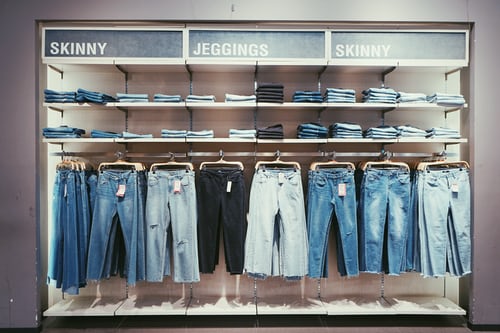Articles & Videos
Funding a Multifaceted Apparel Industry

The apparel industry is unique and not just with regards to the fashions you see hitting the catwalk each season. The industry encompasses all kinds of businesses from designers’ first inception of a brand to importers and wholesalers, retail stores, services-based and more. Funding needs for these businesses can be very diverse depending on the sector and stage that the business is at and for many apparel businesses, traditional bank financing is seldom enough to sustain both cash flow and growth.
What are some of the challenges to the apparel industry?
Predicting the future
Even in a normal pre-COVID world, the main challenge for apparel was being able to accurately forecast consumer trends and behavior well into the future and have a supply chain flexible enough to scale up or down as required.
COVID-19 has done nothing to alleviate this pain point, if anything it’s put the industry into a state of flux. There’s more uncertainty as to what consumers’ lives will look like and what they’re going to spend on as they emerge from remote work into hybrid and from social separation back into integration into normal society once more. There are many more questions for the industry than prior and predicting them is trickier than ever.

Uncertain supply chains
Supply chains are still somewhat unsettled too. Production started to move away from ChIna to other textile hubs around the world, including Malaysia, Vietnam and Bangladesh, however Bangladesh then had their own critical disruptions causing further delays in production. These delays are likely to cause price increases for businesses and in turn, consumers, as higher costs filter down the chain. Protectionist policies in the US from the Biden administration, whilst admirable, may only transpire as more prohibitive to doing business as trade tariffs for importers of textiles, apparel and the equipment needed to produce these goods moves upwards in price.
Supply chains remain unpredictable and goods received late can prove a major headache and a worrisome drain on profits for apparel businesses who have a short window in which to sell through products that are on trend seasonally or risk sitting on unsold inventory.
Capital intensive and competitive
Financing high capital costs with minimal revenue for extended periods is common in the industry but can be a particular barrier to new businesses making it past the first year milestone. Entrepreneurs and startups in the industry usually have to compete with larger, more established companies that are more capable of withstanding lengthy periods of time before they receive payments on invoices.
Immeasurable competition in the market makes it very hard for apparel businesses to set themselves apart from all the rest. More than any other industry, business owners and founders need to be able to prove and articulate how they’re different. The inability to build a brand quickly into profit, often deters banks from providing the financial backing needed to succeed.
Sustainability concerns re-emerging
Everyone knows how our clothes are produced; cheaply and usually for very low cost by low-paid workers in developing countries. Not everyone wants to continue purchasing ‘fast fashion’ for it to contribute to poor working conditions in the producing countries and for the items to then appear in landfill somewhere not much longer later.
Apparel businesses will need to be considering a more conscious consumer going forward, particularly if their target market is a younger demographic. There are various ways businesses will try and tackle sustainability from the materials that are used to produce garments and household textiles to addressing their capabilities with regards to forecasting and unsold inventory. A report from Business Chief revealed that most retailers operate with as little as 70% inventory accuracy which results in excess waste and transportation emissions. Adoption of existing and emerging technologies such as RFID and artificial intelligence will enable highly customized production of inventory based specifically on accurate consumer demand and result in diminished waste.
Light at the end of the tunnel
The signs are good that some level of normality is returning globally and the apparel industry will bounce back from the setbacks of 2020. Businesses will need to be prepared to take advantage of the pent-up demand from consumers who have been busily saving cash during the pandemic and are ready to get out and spend.
Digitalization of the industry will continue, separating those businesses that are able to utilize technology to improve customer shopping experiences, whether that’s online or in-store and providing the insight needed to develop creative ways to manage inventory and supply chain for cost control and agility.
Traditional financing is not always the best fit for the apparel industry and it’s notoriously difficult to secure in fact. Sallyport’s range of flexible financial solutions can be customized to provide financing for all needs. Funding may be used to upgrade facilities, equipment or technology, accept an unusually large order or simply free-up some working capital so that you can concentrate on growing your business.
Whatever your funding needs, reach out to the team today for assistance with understanding the options for your apparel or textiles business.
Search
News
$1M Funding Fuels Agri-Business Growth Across Borders
Sallyport is pleased to announce a new partnership with a Canadian agriculture business, providing a $1,000,000 Accounts Receivable facility to…
Read MoreFueling EdTech Growth with $5.5M in Tailored Financing
Sallyport is excited to support a forward-thinking education technology company with a $5.5M combined Asset-Based Lending facility, including Accounts Receivable…
Read MoreArticles
Financing a Business Restructure and Turnaround
Financing a business restructure is one of many reasons a business may need to supplement their finances. Restructuring is usually…
Read MoreLabor Market Shortages Stifling SME Growth
Since the U.S. has started to resume business-as-normal there’s been talk of a labor market shortage emerging and creating a…
Read MoreVideos
American Business Women’s Day
Sallyport Commercial Finance Celebrates American Business Women’s Day
View NowThe Most Financial Time of the Year
Sallyport commercial finance’s Annual Holiday Music Video!
View Now



